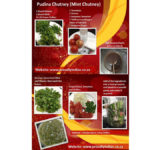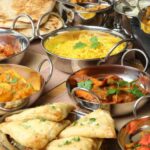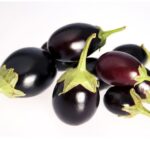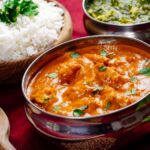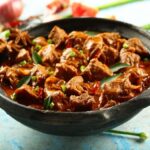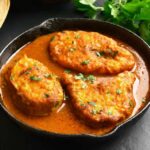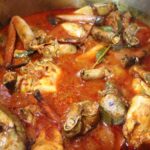Shelley Seid celebrates 150 years of South African Indian cuisine by talking to a hot trio of food experts
Mango achar, Gorima’s potato samoosas in the freezer, guiltily sneaking great wads of sickly sweet burfi at Diwali – these are my own reasons to celebrate 150 years of South African Indian cuisine. It began with the arrival of the first indentured Indians who came to work on the sugar plantations of Natal in 1860 and while it celebrates the traditions of India, it is at the same time singularly unique.
Asha Maharaj, food columnist for the Sunday Times Extra, has coaxed generations of anxious amateurs through the culinary minefield of Indian cookery. With 18 and a half years as the cuisine queen of Radio Lotus, 10 years with the newspaper and three cookbooks to her name, Maharaj is an expert on South African Indian food.
In July 1882, her paternal great-grandfather, Sewsawran Ramnewaj Bharadwaj, arrived from Allahabad in western Uttar Pradesh to work as a contract labourer for the Umhlanga Valley Natal Sugar Company. The Indians who worked the sugar plantations were from different regions – many from Uttar Pradesh and Bihar, but also from Calcutta in West Bengal and from the southeast. They came from different social backgrounds and included Hindus, Christians and Muslims. It was a veritable melting pot that brought a fusion of cooking styles. Asha Maharaj’s family were of Brahmin descent, priests and teachers and mostly vegetarian. Meagre and restricted rations and a need to supplement the pot led to small-scale farming from the outset. Maharaj tells of a herb the women grew between the sugar cane, which they would collect in the folds of their saris and boil with chillies for the evening meal. Chorahi, which means “on the wayside”, is an expensive herb today.
“The fusion of cooking styles has evolved into what can be broadly defined as South African Indian cuisine,” says Maharaj, “but can still be traced back to specific regions – Tamil Indian fish curry from the South for example, or mild North Indian curries.”
Her early food memories go back to her childhood when her family lived in Nonoti on the Kwazulu Natal North Coast. “I would watch the elders picking mushrooms. There were no stoves, just blocks on a cement floor with bars across them on which the huge pots sat. My mother got up daily at 3.30am to make roti to ensure the men went off with a good meal.”
These days, in suburbs that include Chatsworth and Phoenix, elderly aunties still sit in the back yards in front of open fires heating two rods, which they use to singe the hair off trotters and sheep heads. “Tripe and trotters were another adaptation,” says Maharaj, “they were a good source of protein and very economical. Those who could not afford lamb or sheep would eat offal – trotters with sugar beans or tripe with dhal. Today these items come cleaned, bleached, packed in polystyrene and covered in clingwrap.”
Life wasn’t easy for indentured labourers. Complex recipes were simplified and substitutions were made but by all accounts, the food was tasty and innovative. Cane sugar was substituted for palm sugar, mielie rice became an alternative staple, butternut and local beans were adopted into the diet. Rajend Mesthrie, professor of linguistics at the University of Cape Town, whose A Dictionary of South African Indian English goes on sale next month, calls South African Indian cuisine a hybrid of different regional styles of Indian cooking, with local western and African influences.
“Durban is a great blend of north and south but, at the same time, it is to a large extent rural Indian cooking. When I visited India, the smells from the pots in some areas were the same as those in my grandmother’s pots.” Regional blending of culture is the story of our food, he says. “In the plantations where they lived cheek by jowl, each learnt the best from the other and they were playfully rivalrous.”
The indentured Indians were closely followed in the 1870s by “free” or “passenger” Indians, those who paid their way to the province. They had come out to seek their fortunes or to join family members in setting up small businesses and often became traders, hawkers and merchants. One of these was Solly Manjra’s grandfather, a Muslim from Gujurat state and a tailor by trade. When his eldest son was 11, he was apprenticed to Mullah’s Café in Victoria Street to work for chef Mullah Chacha, a man with a reputation, Solly Manjra says, as “the best, the number one, famous” for his sweetmeats and his baked goods. The 11-year-old began as a water boy, serving water to the patrons and, over 34 years, learnt at the feet of the master and then opened his own business.
He began teaching his skills to his 12-year-old son, Solly.
“I loved cooking,” says Manjra. “My father encouraged me. He would wake me at 4am and I’d help prepare the dough for roti.”
Manjra’s caterers is now a Durban institution run by Solly, his two sons and his son-in-law. Weddings, mendhi parties, corporate functions – and if you want a classic mutton biryani there is nothing to beat theirs. Manjra’s has cooked for Sonia Gandhi, for Nelson Mandela (“the best biryani he has ever eaten, he told me,”) and for Mohammed Ali. At Solly Manjra’s premises in Sea Cow Lake, rows of enormous pots sit above gas fires about a foot off the ground. “Big pot cooking” is his passion, he tell me. For the past 10 years he has been part of a project that feeds the underprivileged at Eid each year, where he is solely responsible for cooking for over 50000 people in one day. He shows me a pot that he bought in India that makes enough dhal for 2 000 people. It’s the size of a small jacuzzi.
“I’m 62 now. My sons told me I must now sit in the office and take it easy. I said, ‘I am so sorry.’ I think it will be while I am standing at my pots that God will take me.”
Solly Manjra has carefully written down the recipes his father was taught by Mullah Chacha and passed them on to his sons because, as he says, “Without good food our people would get lost.”
Oral history is plagued by the vagaries of time – it changes, it shifts, it dies, but once written down, it is fixed and ever accessible.
Possibly the most important initiative in recording South African Indian cuisine was the recipe book Indian Delights, first published in 1961, an initiative of the Women’s Cultural Group of Durban. The driving force behind the book that has sold tens of thousands of copies was Zuleikha Mayat. Her grandfather, Hassim Bismillah, arrived in 1879 in Durban and by 1881 had settled in Potchefstroom as a shopkeeper. The shop was inherited by Mayat’s father but eventually run by her mother, a woman who came out from India as a bride, spoke no English or Afrikaans but ran the shop so well that the townsfolk referred to it as “Amina se winkel”.
With no time to teach her daughters to cook, Mayat was expected to learn the culinary arts from her sister, “But I was too busy studying. She did my work for me and I only learnt the basics.” Once married, she moved to Durban where she was central to the founding of the Women’s Cultural Group. The idea of producing a recipe book arose when the group was searching for ways to raise money for their charity work. One member suggested sending a recipe for chevra to Post Toasties to print on their cereal boxes and charging them for it. Mayat went one further and suggested they compile a recipe book and that she edit it.
“Some people asked who would need such a book. ‘I do,’ I told them.”
There were many reasons for such a book. Changing times meant working women had less time to learn from their elders, less time to cook and a need for simple recipes. It was also a way of preserving the recipes that their great-grandmothers had passed onto their grandmothers. A recipe book would gather up the best of the regional cuisines of India and recognise a distinct South African Indian food culture. The group started with a print run of 2000. Within 60 days, they were sold out. Indian Delights, filled with stories, tips and information as well as recipes, has become a classic and essential for every Indian bride.
“Our priests are annoyed that while there may not be a Qur’an in every home there is a copy of Indian Delights,” jokes Mayat. “From the word go, we were getting to know each other’s food while at the same time keeping to the traditions of our forbearers.”
Asha Maharaj says South African Indian cuisine is in a class of its own. “Visiting Indians may think we are not authentic enough. Yes, we enjoy going to restaurants with imported Indian chefs and we marvel at the exotic pastes and meals. But some days you want just want to enjoy rice and dhal and maybe a mango pickle.”
Eating out in Durban
IMPULSE BY THE SEA
Upmarket venue on the North Coast overlooking the ocean. Menu includes non-Indian dishes.
Hot tip: The prawn curry.
Address: 167 Seaview Drive, Tinley Manor Beach, phone 032 554 4626.
GOUNDENS
Flanked by a panel-beater’s and a funeral home, this is an authentic working-class Indian eatery.
Hot tip: Friday’s specialties include trotters and tripe. Go early, the place gets packed.
Address: 39 Eaton Road, Umbilo. Phone 031 205 5363
SILVERANI’S
Silverani Moodley pays tasty tribute to Durban’s unique adaptation of South Indian-style cooking.
Hot tip: This is where to go for hot. The mutton and potato curry is worth a mention.
Address: Suncoast Casino, upper level. Phone 031 368 1396
HOLLYWOOD
Primarily a tote that started a pub and curry outlet on the side, it now has as many feeders as punters.
Hot tip: Many swear by their bunnies.
Address: 126 Intersite Avenue, Springfield Park. Phone 031 263 0457.
THE ULUNDI TAPAS
Upmarket lunch venue that specialises in thali, small bowls of different curries of your choice served on a tray.
Hot tip: Make sure that vindaloo lamb cutlets and creamy prawn and chicken curry are part of your selection.
Address: Royal Hotel, 267 Smith Street. Phone 031 333 6000.
Source Timeslive
Shelley Seid | 21 November, 2010

